Online shopping has quickly become one of America's favorite pastimes, allowing people to make purchases from the comfort of their own home and have goods delivered right to their doorstep. Unfortunately, there are criminals who have no qualms about stealing unattended packages from people's porches.
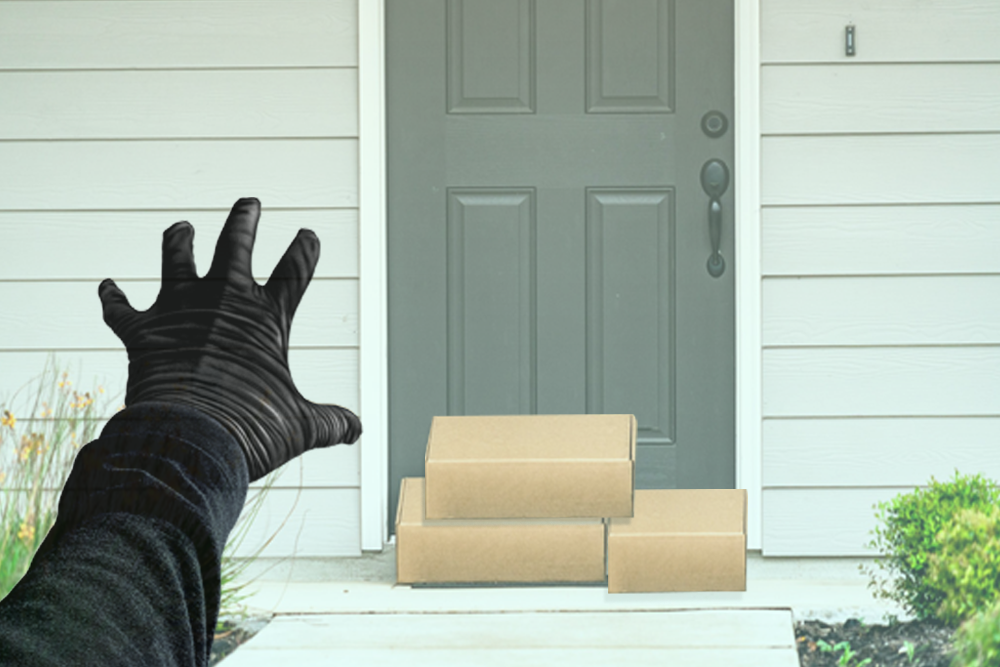
We surveyed over 1,000 people on their "porch pirate" experiences in the past year. How long do respondents feel comfortable leaving their packages outside? What are the most common items that have been stolen? How do people make sure they have the best possible chance of retrieving their goods before they get swiped? From our findings, we'll tackle these questions and many more pertaining to porch pirate statistics across the country.
The Waiting Game
Out of the seven packages reaching American doorsteps on a monthly average, five of them were left on the porch after the delivery had been completed. The contents of a given package amounted to $106, on average. While 12% of respondents didn't feel comfortable leaving a package outside at all, just under a quarter had no problem with it sitting on the porch for an hour, and 46% could easily wait a few hours before retrieving it. Not many people were on board with leaving items unattended for longer than that.
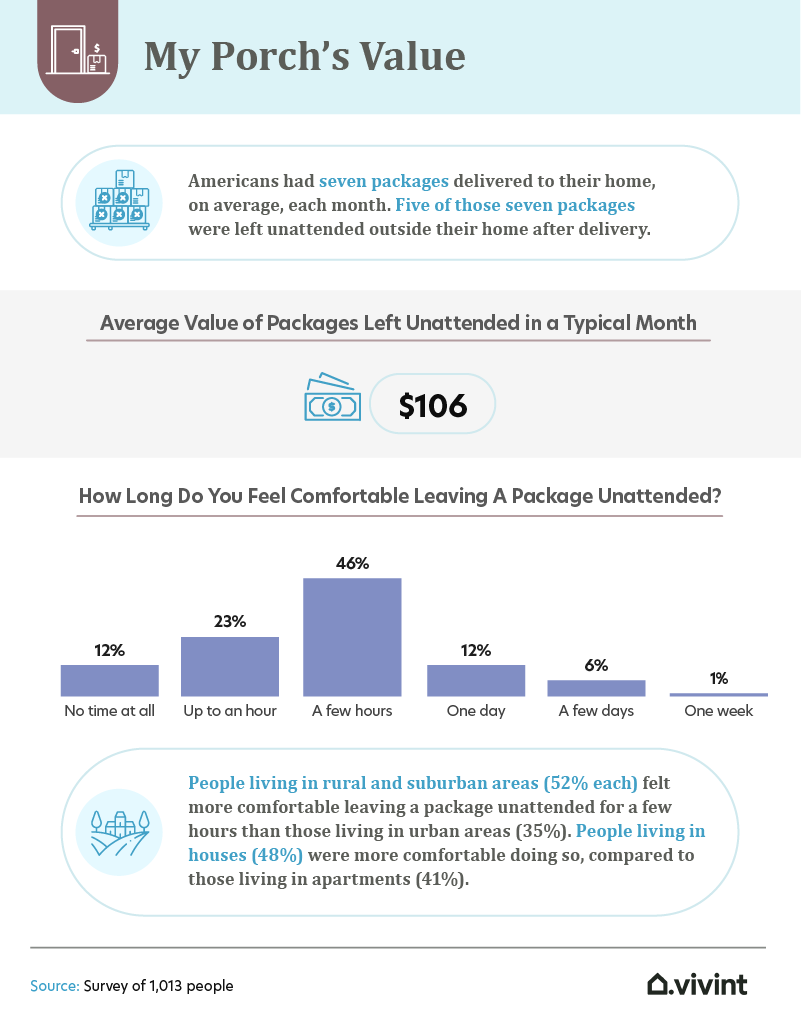
Respondents living in rural and suburban areas and those living in houses didn't worry as much about their packages being stolen as those living in urban areas and apartments. Seeing as how a whopping 1.7 million packages are stolen or lost across the U.S. every day – it might be a good idea to take yours inside as soon as it lands on your front steps.
Stolen Goods
Twenty-nine percent of Americans reported being victims of package theft, and as mentioned, those living in urban areas and apartments were more likely to be targeted. On average, people have had three packages stolen in their lifetime. Surprisingly, even considering the increased orders being shipped to homes due to COVID-19, there was no difference in the average number of packages reported stolen during the pandemic. In general, worldwide retail e-commerce sales have been steadily increasing for a long time and are projected to hit almost $6.4 billion in 2024 (up from the projected $4.9 billion in 2021). With online shopping becoming the norm for many, the average number of packages stolen may very well increase in the near future.
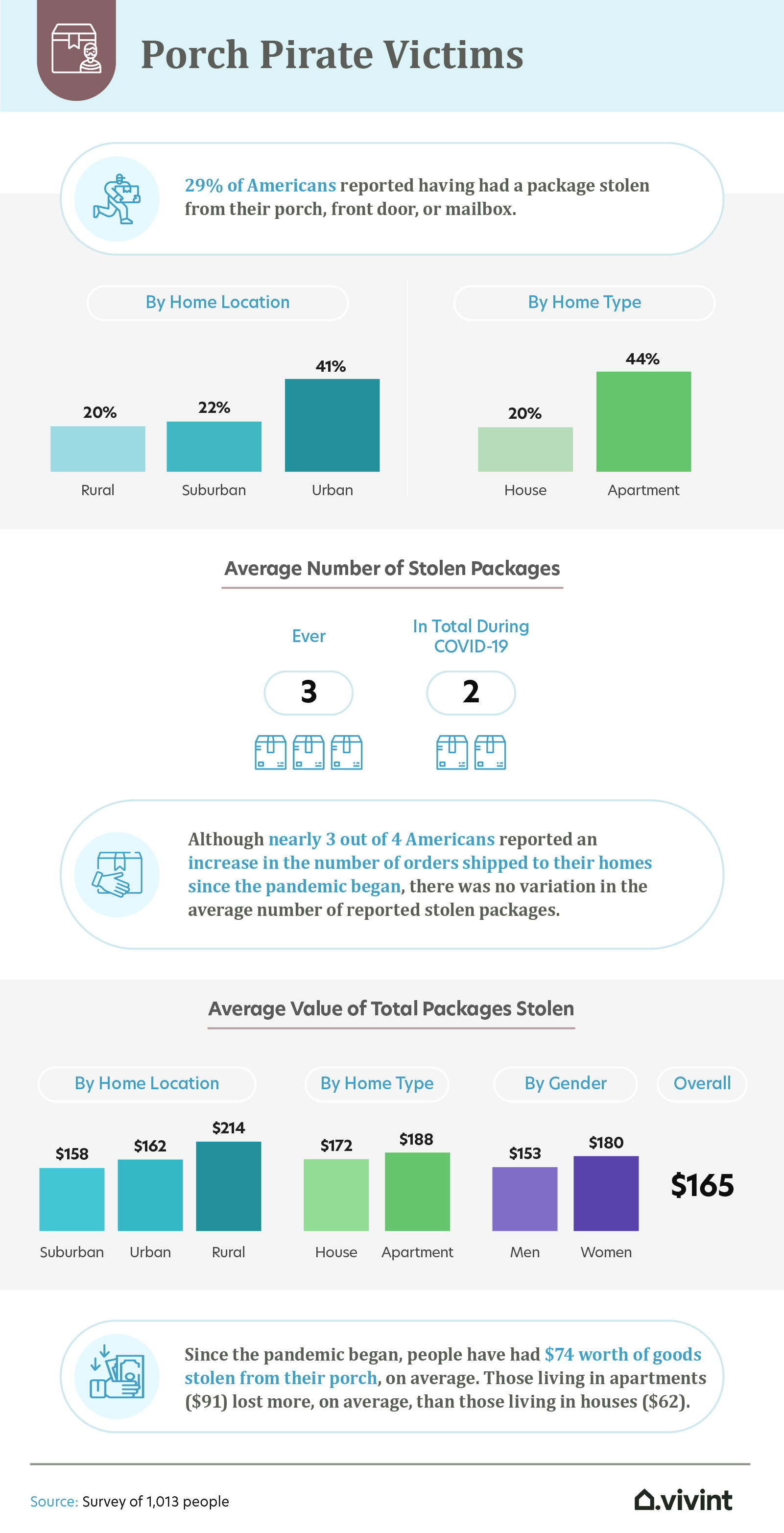
Touching again on the average value of package contents, ones delivered to rural areas tended to cost the most compared to other area types; items dropped off at apartments were slightly more expensive than those delivered to single-family homes; and women's orders were almost $30 costlier than men's, on average.
Theft Variables
By a margin of 10 percentage points, the most stolen package type was those with clothing inside, accounting for a third of both apartment and single-family home theft experiences. Over 20% of respondents reported their stolen items also included books, toys and games, and health and personal care products. Thieves didn't clearly prefer any given day of the week to commit their crime, but Mondays and Tuesdays were the most common days for them to try and get their hands on something. Regarding the time of day, the afternoon was the most likely time for a package to be stolen.
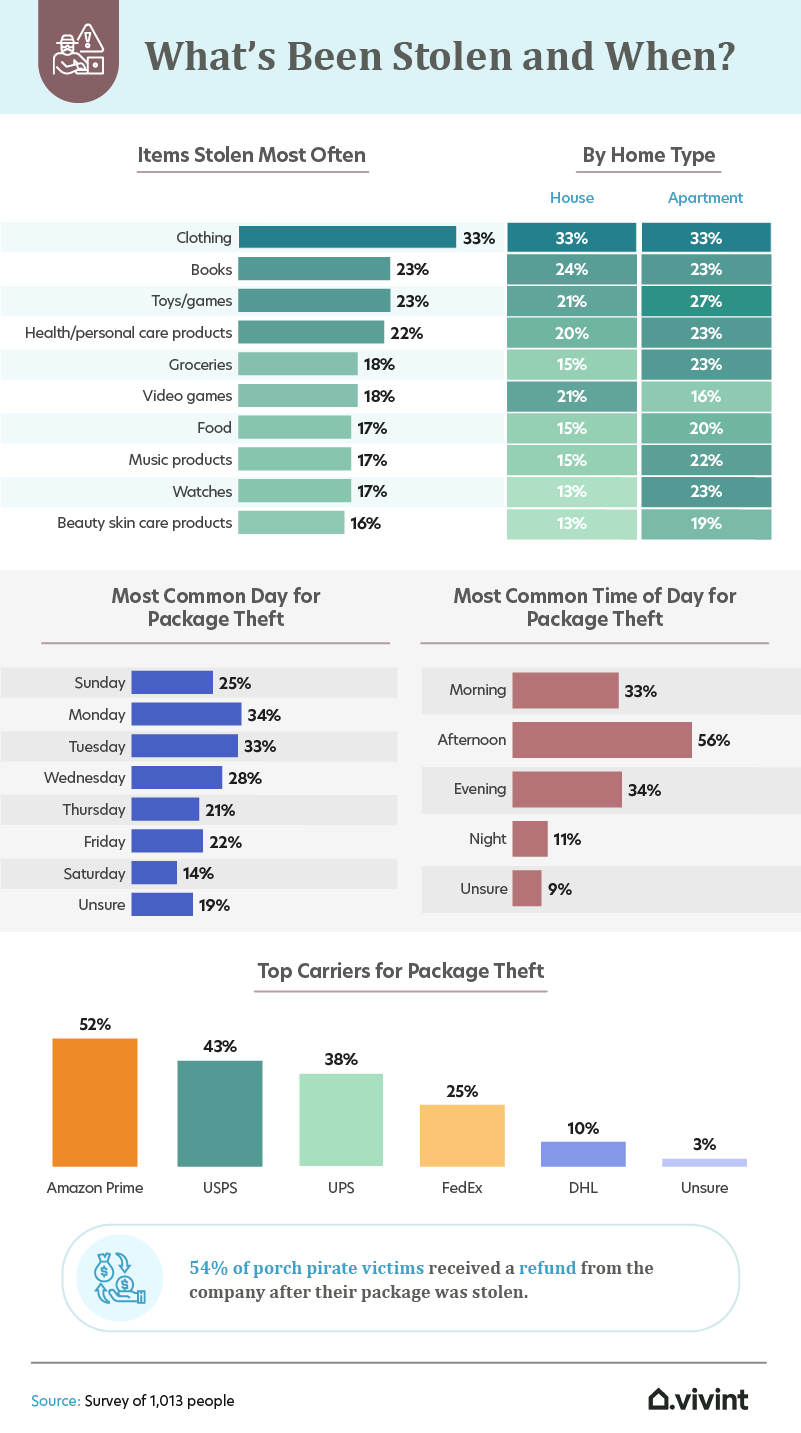
The high amount of clothing stolen may be accounted for by the large size of the online fashion industry. In 2020, the e-commerce apparel industry was projected to amount to $91.7 billion in the United States alone. Pirates may not be actively seeking out clothing items to steal but are ending up with them more often because of the frequency with which Americans are having clothes shipped to their homes.
Among carriers, Amazon Prime has had the most issues with stolen goods. Amazon customer support workers are available to help solve delivery-related issues, and the company even created the ‘A-Z Guarantee Program' to deal with problems related to third-party sellers. Still, many struggle to receive compensation when filing a claim about stolen goods - in fact, regardless of carrier, only 54% of porch pirate victims were refunded when reporting a package as stolen.
Protecting Your Parcels
To negate the potential for package theft, 34% of respondents believed subscribing to delivery alerts was the best way to quickly and safely collect their purchases once they arrived. Meanwhile, nearly a quarter opted to give specific instructions to delivery drivers to ensure the items were not left in a compromising position. Over 20% felt better with heightened security and installed an outdoor security camera or video doorbell to dissuade or catch culprits. Previous victims of porch piracy were also much more likely to have their packages sent to their workplace, while non-victims were less likely to adhere to many of the listed safety precautions.
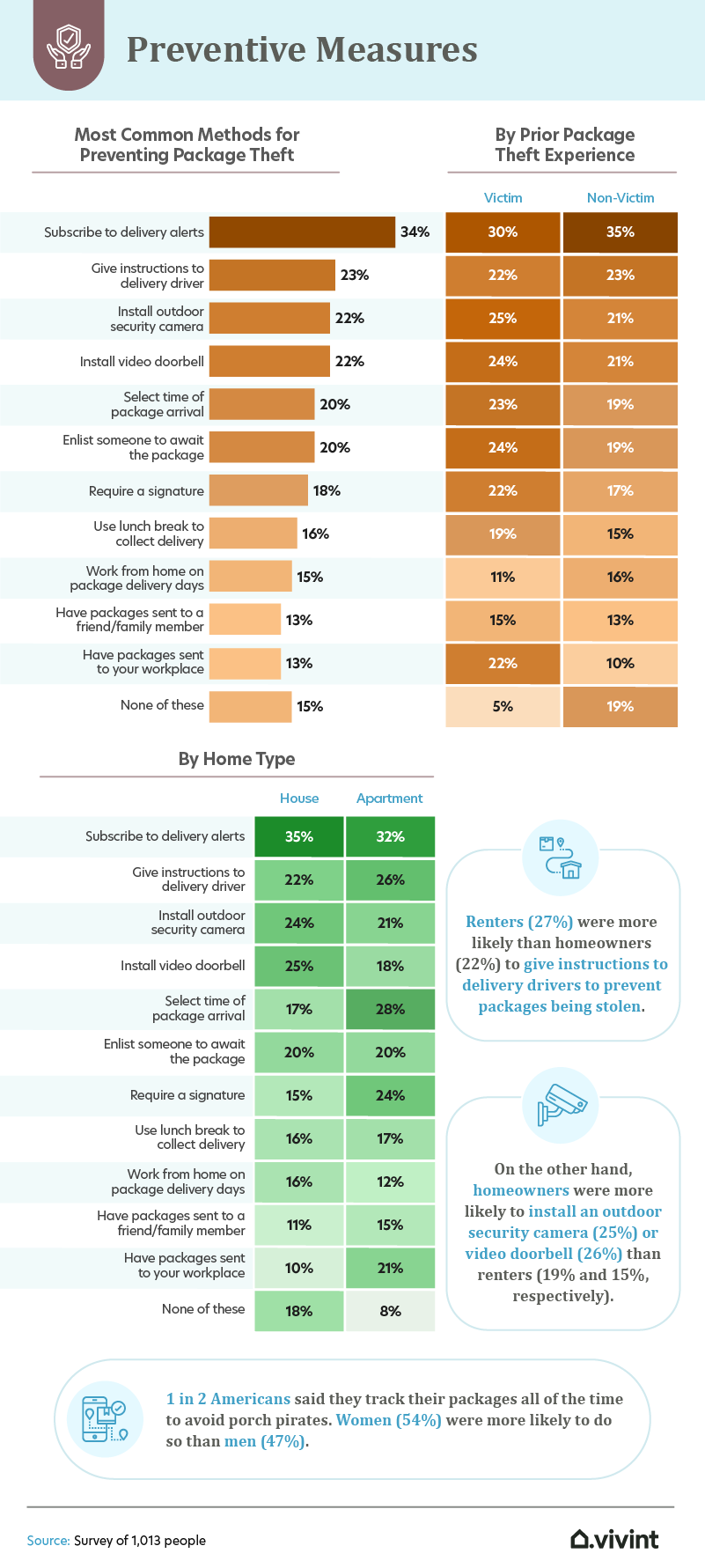
Compared to people living in apartments, more single-family households subscribed to delivery alerts, installed video doorbells, or worked from home on delivery days. On the other hand, apartment dwellers tended to request a specific time of arrival and a signature upon delivery, as well as send their packages to their offices more than homeowners did.
Generally, half of Americans said they closely tracked all their packages to reduce the chance of their purchases getting stolen, and women stayed on top of their inbound orders more than men. To join the fight against porch pirates, companies like Amazon have rolled out smart lockers as means of delivering ordered goods. At checkout, customers can select a locker location near them, where their package will be waiting to be collected. A unique six-digit code is sent to the customer and is required to open the locker, helping ensure the safety of their package until they fetch it.
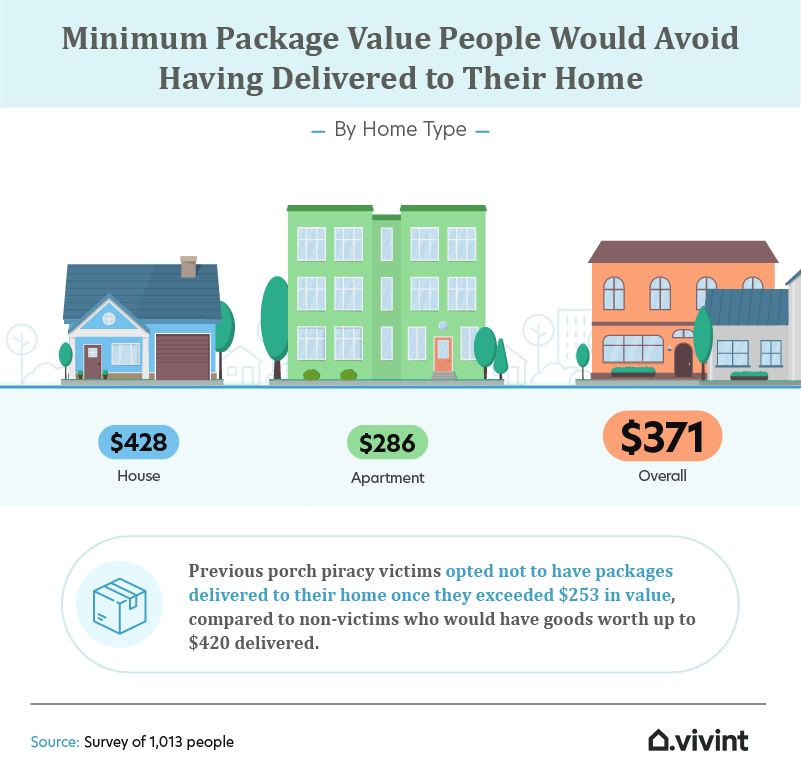
When items were very expensive, people didn't want them sent to their home at all. Single-family households had a higher tolerance than apartment renters, but overall, parcels with a value of $371 or more would be sent elsewhere. Previous victims of porch piracy wouldn't send a package to their home address if the value of the contents was $253 or more, whereas non-victims had a little more leeway, only taking precautionary measures for package values $420 or more.
Aside from redirecting incoming orders to your workplace, another good idea could be to ask your neighbor or local relative to accept delivery of your package for you.
Defending Against Pesky Pirates
Porch piracy is clearly a growing problem across the U.S., but there are ways to ensure the safety and protection of your packages. For example, some people prefer to send their orders to their workplace address, and companies like Amazon have introduced smart lockers as a delivery option to help ensure that only you can collect your parcel.
Nobody should need to worry about having their belongings stolen right off their doorstep, and Vivint can aid in ensuring peace of mind. With a Vivint system, you can communicate with the people on your front porch from anywhere in the world. The Vivint app also makes it easy to remotely open a garage door or gate, so that your delivery can be put in a more secure location. Head over now to put the well-being of your home in the right hands.


